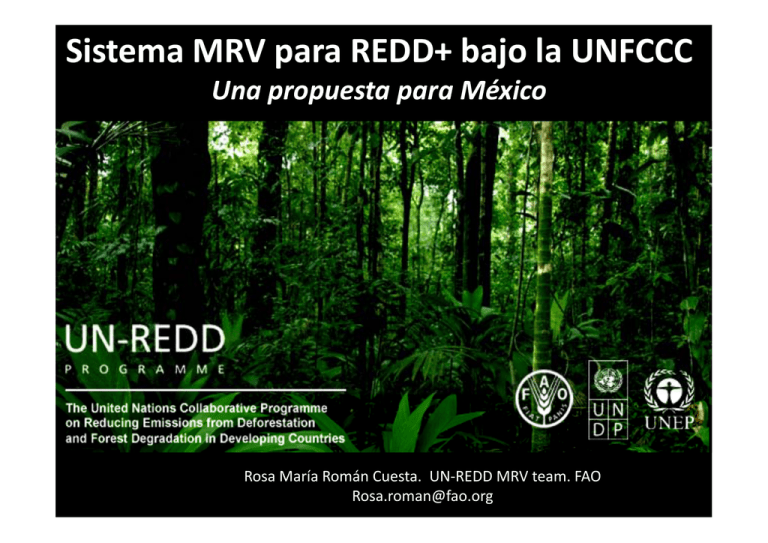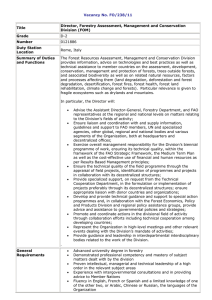Sistema MRV para REDD+ bajo la UNFCCC - REDD/CCAD-GIZ
Anuncio

Sistema MRV para REDD+ bajo la UNFCCC Una propuesta para México Una propuesta para México Rosa María Román Cuesta. UN‐REDD MRV team. FAO [email protected] Solicitudes de reporte bajo la Convención Marco de Cambio Climático (UNFCCC) ( ) 1. Los signatarios del tratado de la UNFCCC tienen la obligación de reportar sus estimaciones nacionales de emisiones y absorciones de gases efecto invernadero (GEI) a través de sus Comunicaciones Nacionales. Nacionales 2. Los países no pertenecientes al Anexo 2. Los países no pertenecientes al Anexo‐II interesados en el interesados en el mecanismo REDD+ deberán establecer (Decision 4/CP.15) • Sistemas nacionales de monitoreo forestal para estimar emisiones y absorciones de GEI del sector forestal, de origen antropogénico existencias de carbono y cambios de area antropogénico, existencias de carbono y cambios de area forestal. • Mecanismo REDD+ Basado en resultados. Mecanismo R asado en resultados. Papel fundamental de los Inventarios Nacionales de GEI Sistemas de MRV bajo la Convención Marco de Cambio Climático (UNFCCC) ( ) Requisitos q 1. Estimaciones de emisiones/absorciones deben cumplir los requisitos de reporte bajo la Convención: transparencia, comparabilidad, consistencia, compleción y exactitud. bilid d i i l ió i d 2 Resultados verificables e incentivos basados en resultados 2. Resultados verificables e incentivos basados en resultados Sistemas MRV como herramienta clave para garantizar que las Partes cumplen con sus compromisos de mitigación. l i d i i ió Componentes básicos de un sistema MRV para monitoreo forestal Context IPCC elements Emission and removals from forests IPCC basic method IPCC basic method A ti it D t Activity Data Emission Factors i i land representation C stock changes X = MRV system elements Satellite Forest Monitoring system National Forest Inventory System Specifications Operational wall-to-wall system based on satellite remote sensing data, with a sampling approach to assess historical deforestation and degradation rates. Changes in forest area to be assessed in order to pp 3 fulfil the IPCC Approach reporting requirements. All data will be presented and distributed through a web GIS system. First NFI to be completed by 2012. Future NFI to be based on continuous sampling system, system e.g. eg Indian forest inventory. Data on carbon stock for all forest carbon pools for the main forest types at IPCC Tier 2 and Tier 3 reporting p g requirements. q The national inventory will be integrated with a community based inventories approach. Emission estimates GHG emissions and removals National GHGs Inventory National inventory for the LULUCF sector developed following the reporting requirements of the Annex-I Parties under the UNFCCC. The inventory will be developed following one of the IPCC default methods: ‘gainloss’ or ‘stock difference’ difference’, but it could also be developed to implement a Tier 3 model. Arreglo institucional como elemento clave para el funcionamiento del sistema MRV Climate Change Leading Agency President In‐country independent review i External independent review i Agency 1 (Satellite Land Monitoring) Agency 2 (National Forest Inventory) QA/QC Agency 3 (National GHGs Inventory) Arreglo institucional como elemento clave para el funcionamiento del sistema MRV Características de reporte del sistema MRV Datos específicos del país, país e incertidumbres asociadas, asociadas para todas las categorías clave. Relación entre sistemas MRV e implementación del mecanismo REDD+ Fase 2: Datos de 1 año de monitoreo de cambios de usos de la tierra + estimaciones conservativas de cambios de existencias de carbono Datos de Actividad Si Sistema Satelital de Monitoreo de los Usos S li l d M i d l U de la Tierra de la Tierra Estratificación del territorio: unidades de carbono similares Land Managed Forest land Un‐managed ‐ Cropland ‐ Grassland ‐ Wetland W tl d Forest land ‐ Grassland ‐ Wetland ‐ Other land ‐ Settlement ‐ Other land Conservation EFCS SMF Exploited Un‐exploited Beach Forest Beach Forest Beach Forest Beach Forest Beach Forest Beach Forest Lowland Forest Lowland Forest Lowland Forest Lowland Forest Lowland Forest Lowland Forest Lower montane F Forest t Lower montane F Forest t Lower montane F Forest Lower montane F Forest t Lower montane F Forest t Mid montane forest Mid montane forest Mid montane forest Mid montane forest Mid montane forest Upper montane forest Upper montane forest Upper montane forest Upper montane forest Upper montane forest Upper montane forest Alpine Forest Alpine Forest Alpine Forest Alpine Forest Alpine Forest Alpine forest Forest tyypes Forest tyypes Forest activities, uses and practices Lower montane Forest Mid montane forest Matriz de cambios de uso del suelo: ejemplo del producto final a obtener como AD Factores de Emisión Inventario Nacional Forestal Inventario Nacional Forestal Estratificación del territorio: unidades de carbono similares GHG Emissions National GHG Inventory National GHG Inventory Tablas de reporte para la Comunicación Nacional basadas en usos de la tierra Category Code and Name 3 B1 Forest Land Definition Gases Emissions and removals from lands with woody vegetation 3 D1 Harvested Wood Products consistent with thresholds used to define forest land in the national GHG inventory, sub‐divided into managed and unmanaged and possibly also by climatic region soil type and unmanaged, and possibly also by climatic region, soil type and vegetation type as appropriate. It also includes systems with vegetation that currently fall below, but are expected to later exceed, the threshold values used by a country to define the forest land category. forest land category. Emissions and removals from managed forests and plantations which have always been under forest land use or other land categories g converted to forest over 20 yyears ago g ((default assumption). Emissions and removals from lands converted to forest land. Includes conversion of cropland, grassland, wetlands, settlements, and other land to forest land. Even abandoned lands which are regenerating to forest due to human activities are also included. Emissions from biomass burning that include N2O and CH4.CO2 emissions are included here only if emissions are not included in 3B categories as carbon stock changes. CO2 net emissions or removals resulting from Harvest Wood Products. 3 D2 Other (please specify) e.g. Emissions and removals from forest land affected by hurricanes 3 B1a Forest Land Remaining Forest Land 3 B1b Land Converted to Forest Land 3 C1 Emissions from Biomass Burning CO2,CH4 N2O,NOx CO, SO2 NMVOC CO2,CH4 N2O NOx N2O,NOx CO, SO2 NMVOC, CO2,CH4 N2O NOx N2O,NOx CO2 Greenhouse Gas Inventories under the Convention Non-Annex 1 p parties “should” use 1996 g guidelines but 2003 Good Practice Guidance are “encouraged” National Communication GHG Inventory National Communication GHG Inventory 1996 Guidelines for National GHG Inventories 2003 Good Practice Guidance for LULUCF Activity Based Land Based Not complete reporting (only key pools Complete reporting (all 5 pools must may be reported) be reported, even if under Tier 1) More flexibilityy on Tier reporting p g levels. Uncertainties should be incorporated p under Tier 2 levels for key sources/removals if donors/market are to evaluate/trust the quality of the reported data. Fire mayy not be reported p if theyy are not Fire emissions must be reported. p key sources Características de reporte del sistema MRV Datos específicos del país, país e incertidumbres asociadas, asociadas para todas las categorías clave. Salvaguardas y Cobeneficios g y Salvaguardas •Gobernanza •Derechos de los Pueblos Indígenas, •Respeto a Convenios Internacionales( i.e. biodiversidad), •Respeto R t a la l no conversión ió d de b bosques naturales t l •Permanencia de reducción de emisiones, •Desplazamiento Desplazamiento de emisiones C b Cobeneficios fi i •Agua A •Biodiversidad







